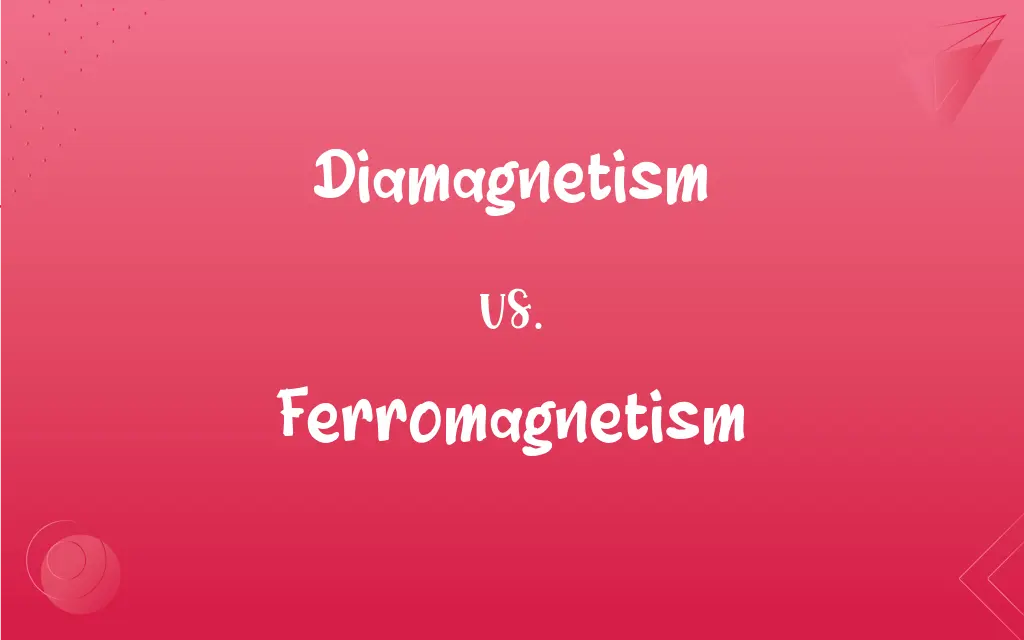Diamagnetism vs. Ferromagnetism: What's the Difference?
Edited by Janet White || By Harlon Moss || Updated on October 26, 2023
Diamagnetism is a weak, universal magnetic response repelling fields; ferromagnetism is a strong attraction creating permanent magnets.

Key Differences
Diamagnetism is a property of all materials, exhibiting a weak repulsion from magnetic fields. Ferromagnetism involves strong attraction, seen in materials like iron.
Diamagnetism results from changes in electron orbits under magnetic fields. Ferromagnetism arises from the alignment of electron spins.
In diamagnetism, the magnetic effect is usually temporary and weak. Ferromagnetism can lead to permanent magnetization.
Diamagnetism occurs in materials like copper and water. Ferromagnetism is found in elements like iron, cobalt, and nickel.
Diamagnetism is temperature-independent. Ferromagnetism often decreases with increasing temperature, losing magnetism above the Curie point.
ADVERTISEMENT
Comparison Chart
Magnetic Response
Weak repulsion
Strong attraction
Origin
Changes in electron orbits
Alignment of electron spins
Magnetization
Temporary, weak
Can be permanent
Typical Materials
Copper, water
Iron, cobalt, nickel
Temperature Effect
Independent
Decreases with temperature
ADVERTISEMENT
Diamagnetism and Ferromagnetism Definitions
Diamagnetism
Induced magnetic moments opposing applied fields.
Water's diamagnetism allows it to be slightly repelled by magnets.
Ferromagnetism
Alignment of electron spins.
Ferromagnetism in cobalt is due to the parallel alignment of electron spins.
Diamagnetism
Weak repulsion from magnetic fields.
Graphite exhibits diamagnetism by levitating above a magnet.
Ferromagnetism
Strong magnetic attraction.
Iron's ferromagnetism makes it useful in making permanent magnets.
Diamagnetism
Independent of temperature.
Diamagnetism in bismuth remains constant regardless of temperature.
Ferromagnetism
Affected by temperature.
Heating above the Curie point diminishes ferromagnetism in nickel.
Diamagnetism
Universal magnetic property.
Diamagnetism is observed in all materials to some degree.
Ferromagnetism
Found in certain metals.
Ferromagnetism is a key property of rare earth magnets.
Diamagnetism
No permanent magnetization.
Diamagnetism does not create permanent magnets.
Ferromagnetism
Leads to permanent magnetization.
Ferromagnetism allows steel to become a permanent magnet.
Diamagnetism
Of or relating to a substance that generates a magnetic field in the direction opposite to an externally applied magnetic field and is therefore repelled by it.
Ferromagnetism
Of or characteristic of substances such as iron, nickel, or cobalt and various alloys that exhibit extremely high magnetic permeability, a characteristic saturation point, and magnetic hysteresis.
Ferromagnetism
(physics) The phenomenon whereby certain substances can become permanent magnets when subjected to a magnetic field.
Ferromagnetism
Phenomenon exhibited by materials like iron (nickel or cobalt) that become magnetized in a magnetic field and retain their magnetism when the field is removed
FAQs
Is diamagnetism strong?
No, it's generally weak.
What causes diamagnetism?
It's caused by changes in electron orbits.
Do all materials show diamagnetism?
Yes, to varying degrees.
What causes ferromagnetism at the atomic level?
The parallel alignment of electron spins.
What's a key feature of ferromagnetism?
Strong magnetic attraction.
What's a common use of ferromagnetic materials?
In making permanent magnets and storage devices.
Which materials exhibit ferromagnetism?
Mainly iron, nickel, and cobalt.
Do diamagnetic materials have magnetic fields?
They create weak, induced fields in opposition.
Can ferromagnetism be enhanced?
Yes, by processing and alloying.
Does every ferromagnetic material have the same strength?
No, it varies among materials.
What happens to ferromagnetism at high temperatures?
It decreases, often disappearing above the Curie point.
Is ferromagnetism common in everyday objects?
Yes, especially in magnetic objects.
Can diamagnetism be observed easily?
It's subtle and often requires sensitive equipment.
Are there technological applications of diamagnetism?
Limited, but it's used in certain levitation experiments.
Can ferromagnetism be permanent?
Yes, in some materials.
How is ferromagnetism used industrially?
In making magnets and magnetic devices.
Is diamagnetism a temporary effect?
Yes, it only occurs in the presence of an external field.
Does temperature affect diamagnetism?
It's usually temperature-independent.
Can diamagnetism create magnets?
No, it doesn't lead to permanent magnetization.
Are diamagnetic materials repelled by magnets?
Yes, but very weakly.
About Author
Written by
Harlon MossHarlon is a seasoned quality moderator and accomplished content writer for Difference Wiki. An alumnus of the prestigious University of California, he earned his degree in Computer Science. Leveraging his academic background, Harlon brings a meticulous and informed perspective to his work, ensuring content accuracy and excellence.
Edited by
Janet WhiteJanet White has been an esteemed writer and blogger for Difference Wiki. Holding a Master's degree in Science and Medical Journalism from the prestigious Boston University, she has consistently demonstrated her expertise and passion for her field. When she's not immersed in her work, Janet relishes her time exercising, delving into a good book, and cherishing moments with friends and family.































































